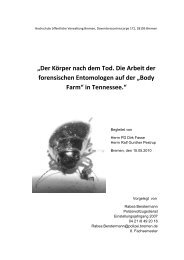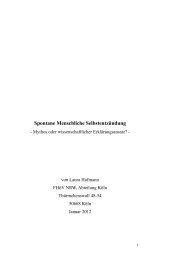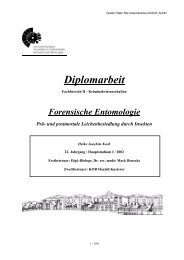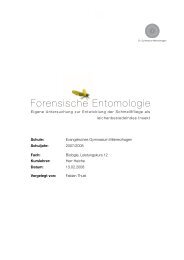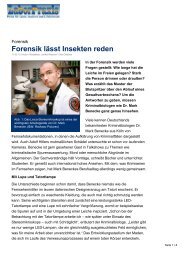A brief survey of the history of forensic entomology - Wiki2.benecke ...
A brief survey of the history of forensic entomology - Wiki2.benecke ...
A brief survey of the history of forensic entomology - Wiki2.benecke ...
Create successful ePaper yourself
Turn your PDF publications into a flip-book with our unique Google optimized e-Paper software.
32 MARK BENECKE<br />
Fig. 14: A case reported by CASPERS (1952). A caddis-fly larvae have built in <strong>the</strong>ir shelters <strong>the</strong> red<br />
fibers <strong>of</strong> <strong>the</strong> socks <strong>of</strong> a dead woman, thus, giving evidence for <strong>the</strong> period <strong>the</strong> corps was in <strong>the</strong><br />
water.<br />
Abb. 14: Ein von CASPERS (1952) berichteter Fall, in dem von Trichopteren-Larven in ihre Wohnröhren<br />
eingearbeiteten rote Sockenfasern Anhaltspunkte für die Liegezeit der Leiche im Wasser<br />
gaben.<br />
had clearly been used to build <strong>the</strong> casing.<br />
However, <strong>the</strong> fibers were only found at <strong>the</strong><br />
very top, and <strong>the</strong> very bottom <strong>of</strong> <strong>the</strong> casing<br />
which meant that <strong>the</strong> fly had already built her<br />
case before she entered <strong>the</strong> sack. She <strong>the</strong>n finished<br />
<strong>the</strong> casing (fibers on top) and attached<br />
it to <strong>the</strong> sock (fibers on bottom). Since <strong>the</strong><br />
attachment procedure lasts at least some days,<br />
it was estimated that <strong>the</strong> body was lying in<br />
<strong>the</strong> water for at least one week. Fur<strong>the</strong>r criminal<br />
evidence led to <strong>the</strong> conclusion that <strong>the</strong><br />
entomological result indicated that <strong>the</strong> body<br />
had been stored elsewhere before it was<br />
dumped. With <strong>the</strong> description <strong>of</strong> CASPER’s<br />
case, our historic <strong>survey</strong> on <strong>forensic</strong> <strong>entomology</strong><br />
ends.<br />
8. Recent History<br />
Between <strong>the</strong> 1960’s and 1980’s, <strong>forensic</strong> <strong>entomology</strong><br />
was maintained primarily by LE-<br />
CLERCQ (1968), LECLERCQ & QUINET (1949),<br />
LECLERCQ & BRAHY (1990) (Belgium) and<br />
pr<strong>of</strong>essor <strong>of</strong> biology P. NUORTEVA ET AL.<br />
(1967, 1974) (first, Helsinki Zoological Museum,<br />
later, pr<strong>of</strong>essor at <strong>the</strong> Department <strong>of</strong><br />
Environmental Protection and Conservation,<br />
University <strong>of</strong> Helsinki, Finland, Fig. 15), with<br />
a focus on case work, German doctors with a<br />
specialization in <strong>forensic</strong> medicine POLLAK &<br />
REITER (1988), REITER (1984, 1985), REITER<br />
& WOLLENEK (1982, 1983, 1985) and REITER<br />
& HAJEK (1984), and in <strong>the</strong> United States, by<br />
GOFF (2000), GREENBERG & KUNICH (2002),<br />
LORD et al. (1986, 1992, 1994, 1998) and LORD<br />
& BURGER (1983), amongst o<strong>the</strong>rs (Fig. 16).<br />
NUORTEVA (1977) and NUORTEVA ET AL.<br />
(1974) wrote an important and quite lengthy<br />
handbook article about <strong>forensic</strong> <strong>entomology</strong><br />
that inspired many researchers (e.g. NUORTEVA<br />
1977). K. SMITH, <strong>the</strong>n head <strong>of</strong> <strong>the</strong> fly collection<br />
in <strong>the</strong> British Museum (London),<br />
published <strong>the</strong> very influential “Manual <strong>of</strong><br />
Forensic Entomology” (1985, 1986) that, in<br />
his own words, holds mostly historical value<br />
but in spite <strong>of</strong> this is still in good use in<br />
some laboratories.<br />
Since <strong>the</strong>n, basic research and advanced application<br />
<strong>of</strong> <strong>forensic</strong> <strong>entomology</strong> opened <strong>the</strong><br />
way to routine casework. It seems that recent



